PinotFile: 9.28 August 14, 2013
|
Rocking K Vineyard: Carneros JewelThe Los Carneros AVA, including parts of both Napa and Sonoma counties, is one of the few regions known for Pinot Noir that does not have many small boutique producers. Laws were instituted years ago to preserve the pastoral heritage of the region (it was previously largely dairy and sheep grazing land), and the land cannot be subdivided into parcels less than 160 acres (Napa, in comparison, allows subdivision into as little as 40 acres). The result has been that the only people able to purchase land have been large producers. The small parcels remain because they were grandfathered in. I have written about the few small, boutique Los Carneros producers in the past such as Adastra Wines, Bonneau Wines & Vineyard, Campesino Cellars, Kazmer & Blaize, Molnar Family and Valerie’s Vineyard. Covering 90 square miles along the low declining hills of the Mayacamas range as it approaches San Francisco Bay, the Los Carneros region is known historically for landmark viticultural research conducted by Louis M. Martini at Stanly Ranch and Francis Mahoney at Carneros Creek Winery. Pinot Noir and Chardonnay, grown for both still and sparkling wine, had a significant presence in Los Carneros long before those grapes reached significant plantings in the Russian River Valley, Anderson Valley, Santa Lucia Highlands and Santa Rita Hills.
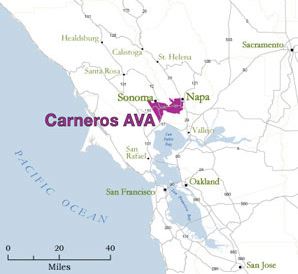 Recently, I received an invitation to visit Bobby Kiel, the proprietor of Rocking K Vineyard in Los Carneros. Bobby, and his spouse Char, purchased their 3 acre property and 1.3-acre vineyard in 2010, which is located off Broadway and Splude Rd, about 2 miles south of the historic Sonoma Plaza, and across the street from the famed Sangiacomo Vineyard. I only knew that the small vineyard was on the site of a previous chicken farm, was planted in 1997 to Pommard 5 clone, and that the first vintage of Rocking K Vineyard Pinot Noir was 2010. I was in the area last week and stopped by for a look and taste. Upon arrival, I was invited into the Kiel’s home to taste the 2010 and 2011 vintages while they filled me in on their story. Bobby had a successful career in the restaurant industry and commercial real estate and Char is an interior designer and former furniture store owner. Together, they transformed this property from a dilapidated ranch into a beautifully landscaped, very welcoming spread consisting of the owner’s abode, two fitted-out rental cottages, a wine storage barn, and a beautifully tended Pinot Noir vineyard. The name of the vineyard and winery is derived from Bobby’s surname.
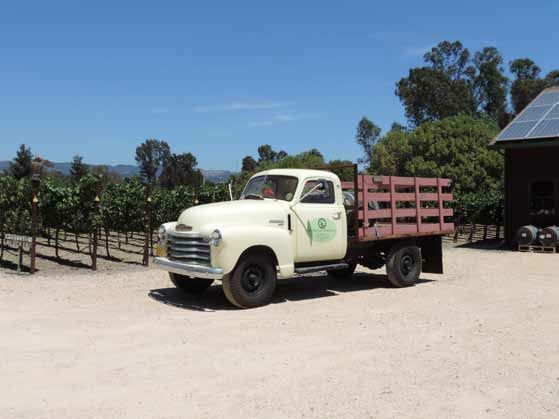 Bobby told me he is a defector from the world of Cabernet Sauvignon and Zinfandel, now enjoying the “nuance, subtlety and power of Pinot Noir." His vineyard receives plenty of love and attention (a vineyard management company agreed to farm the tiny vineyard) and the resulting wines show it. A single estate Pinot Noir is produced from the Rocking K Vineyard. The winemaker for the 2010 vintage was Scott Rich (Talisman) and for the 2011 and 2012 vintages Michael Peters (Kasuari Wines). The wines are vinified with native fermentation and bottled without fining or filtration. After tasting the 2010 and 2011 vintages at the Kiel’s home, I was blown away! Very cool packaging too. I told Bobby he was a very lucky man because Pommard seemed to love his site. I am a big fan of the Pommard clone anyway, and often say that Pommard is my paramour. Tasting is available by appointment at Rocking K Vineyard by contacting Bobby at 415-601-4299 or email at bobby@rockingkvineyard.com. Wine purchases can be arranged through Bobby as well. There is some restaurant and retail availability in Northern California (visit the website at www.rockingkvineyard.com). The two rental cottages have a beautiful view of the countryside and vineyard and are perfectly located for a wine country visit to Carneros and Sonoma. Contact Char at 415-609-4299 or by email at char@rockingkvineyard.com. Guests receive a discount on wine purchases. A 2012 Rocking K Vineyard Sparkling Brut Rosé (30 cases) will be released in the spring 2014.
2010 Rocking K Vineyard Single Vineyard Los Carneros Pinot Noir 14.1% alc., 128 cases, $55. 100% de-stemmed and aged in 33% new French oak. · Moderately light reddish-purple color in the glass. Lovely aromas of fresh Bing cherries, ripe strawberries and cardamom spice which maintain over time. Delicious middleweight core of dark cherry flavor with accents of cola, anise and spice. Enticing finesse and supple, well-balanced tannins. Ready to drink now but the balance will keep this wine fresh for years. Like cherry pie day at cooking school: cherries, baking spices and very interesting results. Will work beautifully at the table, complementing rather than fighting with food. Score: 95
2011 Rocking K Vineyard Single Vineyard Los Carneros Pinot Noir 13.9% alc., 75 cases, $55. 100% destemmed. Aged in 33% new French oak. · Medium reddish-purple color in the glass with a slight amount of sediment. Deeply perfumed with scents of Bing cherries, dark chocolate, spice and subtle oak. Darker and a little denser than the 2010 vintage but sharing a very similar flavor profile of dark cherries, cola and spice. Seductively soft and silky in texture, offering balanced tannins and nicely integrated oak, finishing with plenty of Pinot singing. Score: 94
2012 Rocking K Vineyard Single Vineyard Los Carneros Pinot Noir 14.1% alc., Unreleased. 50% whole cluster. Aged in 40% new French oak. · Medium reddish-purple color in the glass. Aromas of black cherries, spice, s’mores and espresso. Brilliant Bing cherry flavor with a delicious finishing kick of fruit. Plenty of cola and oak-driven notes are evident. The tannins are suave and the mouth feel is dreamy. Could turn out to be the best and most age worthy of the three vintages sampled here. Tasted the following day from a previously opened and re-corked bottle, the wine showed more whole cluster driven spice and much better integration of oak. Yummy. Score: 95
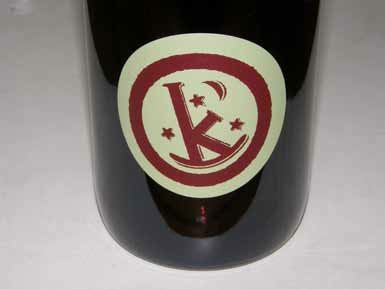
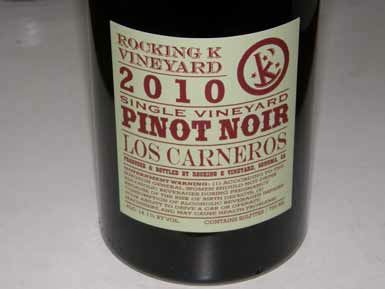
On the Pinot Trail at West of West Festival, Part I: West Sonoma CoastIn 2011, a group of wineries and growers on the far western, coastal part of the Sonoma Coast AVA joined to form the West Sonoma Coast Vintners (WSCV) association. The goals of the organization were to facilitate collaboration among members of the unique region, preserve and protect the history, landscape and culture of West Sonoma Coast, and promote the wines from the West Sonoma Coast to the media, trade and consumer. Members are advocates for wines with a clear identity evoking the complexity of the region and the authenticity of the community. The WSCV vintners and growers are located inland within a short distance of the Pacific Ocean shoreline, within a climate ideal for a special expression of Pinot Noir and Chardonnay. The growing season is cool, dry and extended so that grapes develop intense flavor and acidity without high sugar. This cool climate viticulture is literally farming on the edge, where grapes struggle to ripen resulting in a dynamic tension in the wines. Many consider the region one of the epicenters of Pinot Noir in California. Matt Kramer (New California Wine) noted, “One thing is already clear: Sonoma Coast West is an extraordinary location for Pinot Noir.” Veteran winemaker Ted Lemon (Littorai) has said, “There is no place I’ve ever heard of like it. The coast is a laboratory for place-specific winemaking.” The Sonoma Coast AVA is an unwieldy 750 square miles or 517,000 acres, nearly half of Sonoma County. It is
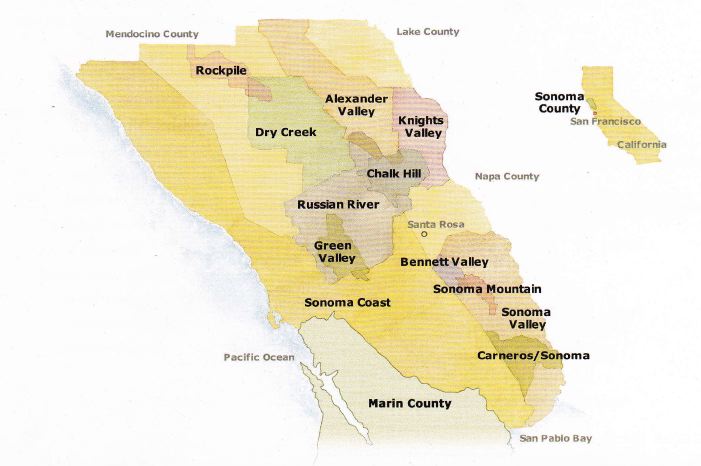 larger than the size of Burgundy, including Chablis, the Côte d’Or, the Côte Chalonnaise and the Maconnais. Formed in 1987 primarily through the wishes of Sonoma-Cutrer Vineyards who wanted to include all their scattered major vineyards in one boundary so they could use the “estate bottled” designation on their labels, the vast Sonoma Coast AVA extends from the Sonoma County border with Napa in Carneros bordering on San Pablo Bay, to Marin County and the Pacific Ocean 30 miles to the West, progressing north through Sonoma County, and reaching its most northern limits at the Mendocino County border. It overlaps five other Sonoma County AVAs including the Sonoma part of Carneros, a sliver of Sonoma Valley, the western part of Chalk Hill, all of Green Valley, and most of the Russian River Valley. The overlap between the Sonoma Coast AVA and Russian River Valley AVA has created some confusion in labeling as Pinot Noir grown in parts of the Russian River Valley can be designated Sonoma Coast. Because of the enormous size of the Sonoma Coast AVA, an unofficial subdivision has been created designated West Sonoma Coast, which makes up about 10% of the entire Sonoma Coast AVA. A number of names have been proposed in recent years for this subdivision including “far,” “true,” and “real,” but the WSCV prefer the region to be addressed as the West Sonoma Coast. The West Sonoma Coast subdivision, as shown in the map below, extends roughly from Jenner in the South where the Russian River empties into the Pacific Ocean to Annapolis in the North, and from the beaches to 5 to 12 miles inland including the first three ridges of the Coastal Range of mountains, extending more easterly in the South to include Freestone, Occidental, Green Valley and Sebastopol Hills where coastal ridges flatten out.
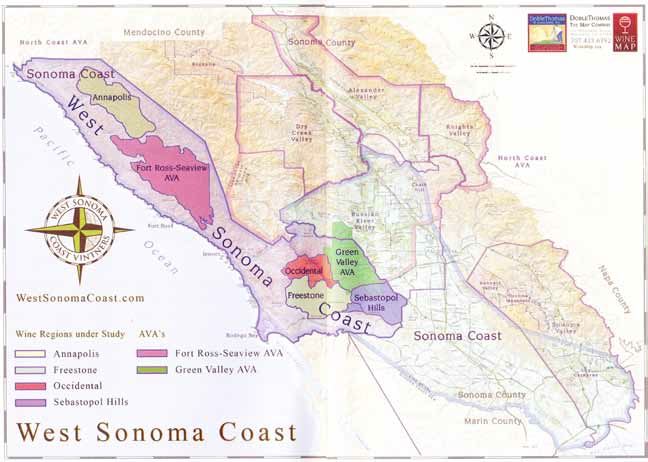 Referring to the map above, the West Sonoma Coast has been unofficially divided into six subregions that are so dramatically different that they warrant further study. From north to south, these include Annapolis, Fort Ross-Seaview, Freestone, Occidental, Green Valley and Sebastopol Hills. The 27,500 acre Fort Ross-Seaview subregion officially became its own AVA in on January 12, 2012, (see Part II and III of this report). The entire Sonoma Coast has over 7,000 acres of vineyards, dwarfing the over 700 acres found in the West Sonoma Coast (exact figures are not available). The West Sonoma Coast has few wineries (Annapolis, Flowers, Freeman Winery & Vineyards, Joseph Phelps Freestone, Hirsch, Littorai, Marimar Estate and Peay), but over 50 growers farming mostly small vineyard plantings except the 300-acres on a 600-acre parcel near the hamlet of Annapolis owned by Kendall-Jackson. The biggest challenge facing growers in the West Sonoma Coast is unprofitably small yields making farming not for the faint of heart. The West Sonoma Coast is defined by coolness with most areas having less than 2,500 degree days of heat during the growing season (Region I). This subregion of the Sonoma Coast is for the most part significantly cooler than the Willamette Valley and Beaune in Burgundy. The West Sonoma Coast has been described as follows: “Most Sonoma Coast vineyards are soaked with sun and waiting for the fog to come in; the West Sonoma Coast is in the fog waiting for the sun to come out.” Ted Lemon, who was an early proponent of the West Sonoma Coast, points out that the West Sonoma Coast is a highly diverse and complex region and there is much to be learned about the proposed subregions. There is an endless array of mesoclimates and soil types. The learning process about the region, one of the purposes of the WSCV, will take generations.
Part II: History of Fort Ross-Seaview Area
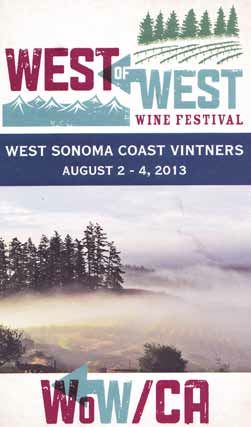
The first wine grapes in Sonoma County were planted by the Russians at Fort Ross in 1817 using Peruvian grape cuttings, and some wine grapes were grown before Prohibition, but the modern era of winegrowing in the West Sonoma Coast began with Michael Bohan. I spoke with Michael’s son, George, and he related the following historical information. Bohan’s family were ranchers near Fort Ross, running sheep, and raising turkeys and dairy cows, among other things, since the middle of the nineteenth century. Michael (known by his friends as “Mick”) bought his grandfather’s ranch in Cazadero on Bohan Dillon Road in 1946 using GI Bill money he received from serving in World War II. He grew a number of crops on his ranch that was situated on a ridge top at 1,400 feet elevation. In 1972 (the dates 1971 and 1973 are both incorrectly mentioned in the wine literature), he developed a vineyard, initially planting 1 acre of Zinfandel (which is still thriving). When Michael enlisted in World War II, he met Mel Pedroni from Healdsburg, whose family had vineyards and the two became lifelong friends. Mel’s son, Danny, managed the Gallo vineyards in Sonoma. The Pedronis help Michael with his initial vineyard plantings. At the time, the University of California at Davis viticulture experts advised against planting grapes in Cazadero hills as they believed it was too cool. Undeterred, Bohan developed more small vineyards including plantings of Chardonnay, Riesling and Pinot Noir. By 1985, Bohan’s acreage had reached close to 39 acres (about 20 acres of Pinot Noir). The first crop from Bohan Vineyard was sold to Martini & Pratti in 1978. Beginning in 1979 and through 1985-1986, the grapes were sold to Felton Empire in the Santa Cruz Mountains. Small lots of Pinot Noir and Riesling were also sold to Sea Ridge Winery. Beginning in 1986 and continuing until 2000, grapes were sold to Robert Stemmler and practically all of Stemmler Pinot Noir releases were 100% Bohan Vineyard fruit. The Riesling in the vineyard was grafted over to Merlot and performed beautifully on the site. Merlot grapes were sold to Beulieu and Fetzer, and the grapes were said to be as good as those from Napa. When the Robert Stemmler label was sold to the Racke family, and the Bohans were not longer working with Stemmler, the grapes were sent to La Crema. To this day all Bohan Vineyard grapes are sold. In the current vintage, Pinot Noir grapes are to be sold to Failla, Flowers and Kutch. The selections of Pinot Noir planted at Bohan Vineyard are unknown. George says that back in the early 1970s when his dad started planting Pinot Noir, the norm of the time was to call a nursery and ask for “Pinot Noir,” without specifying a clone or selection. Because the Pinot Noir performed so well initially on the site, the Bohans have stuck with the original selection. A number of experts have looked at the vines but they are in disagreement about its origins. George says it might be Martini. Bohan was much respected by those who knew him and was admired for logging, running sheep and tending his vineyards well into 60s. David Hirsch said about “Mick,” “He was God’s gift to humanity - a regular salt of the earth individual.” His son, George, entered the commodities trading business after college, but returned in 1986 when Michael was 66 years old to help out on the ranch. George left his employer on a leave of absence, but never returned, and today still lives on the ranch and manages the 35 acres of vineyards. A number of others established plantings that included Pinot Noir either initially or eventually in the Cazadero area east of Fort Ross by the late 1970s and early 1980s as the sheep industry in the area was being phased out. This included the Schatzbergs (Precious Mountain Vineyard, beginning in the mid 1970s)), David Hirsch (Hirsch Vineyards, 1980), the Schoenfelds (Wild Hog Winery, 1981), and Tim Schmidt and Dan Wickham (Sea Ridge Winery, early 1980s). The Charles Ranch Vineyard was planted to Chardonnay with the assistance of Lee Martinelli, Sr., in 1980.
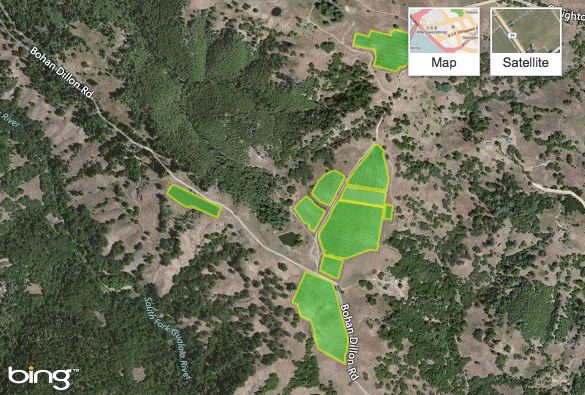 Donnie and Linden Schatzberg, former Peace Corp participants, homesteaded land for a vineyard in Cazadero in about 1970. In the mid 1970s, they planted Gewürztraminer, Riesling and some hybrids, later grafting most of it over to Pinot Noir and eventually reaching 2.3 acres of vines. Today, there are still a few Gewürztraminer canes in the vineyard. All the grapes from Precious Mountain Vineyard have been sold to Williams Selyem since 1996. Precious Mountain Vineyard is pictured above (www.everyvine.com). David Hirsch purchased a 1,100-acre sheep ranch on a remote chain of ridge tops 900 feet above the Pacific Ocean at the end of Bohan-Dillon Road in 1978. Upon the advice of Santa Cruz Mountains winegrower friend Jim Beauregard, he decided to plant Pinot Noir. Beauregard visited Hirsch property and said, "If you plant Pinot Noir here, this will be a world-famous vineyard. Beginning in 1980, Hirsch established his first 2-acre planting of vines that he acquired from Beauregard. The planting began in earnest by 1990 and would eventually encompass 68 acres of Pinot Noir and 4 acres of Chardonnay on several ridge tops above the fog line at 1,341 feet elevation a few miles inland from the Pacific Ocean. The vineyard became world-renowned and the name, Hirsch Vineyard, quickly became synonymous with the West Sonoma Coast. (Below: aerial photo I took a few years ago and total vineyard view sourced from www.everyvine.com)
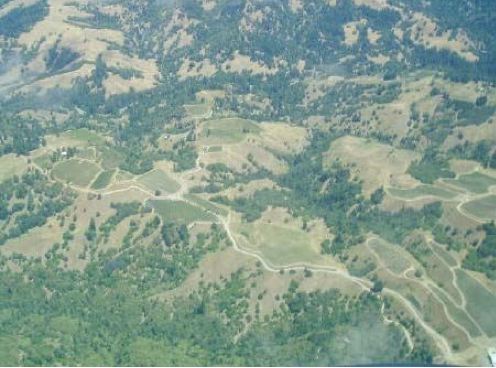
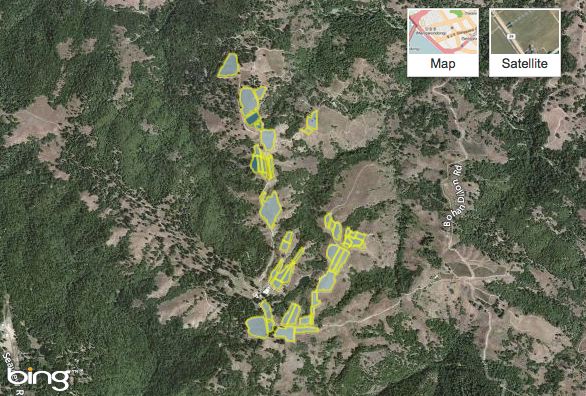 Daniel and Marion Schoenfeld settled on a property in Wild Hog Canyon 40 minutes west of Cazadero, about 3.5 miles from the coast at 1,400 feet elevation. They first planted Zinfandel and Gewürztraminer in 1981, later grafting over the Gewürztraminer to Pinot Noir. At the time they began planting, there were about 30 to 40 planted acres in the Cazadero area. Over a ten year span, the vineyard reached 5 acres in size eventually planted to Pinot Noir, Zinfandel, Petite Sirah, and Syrah. The Wild Hog Winery became bonded in 1990 and today the estate extends over 110 acres. The Wild Hog Vineyard is pictured below.
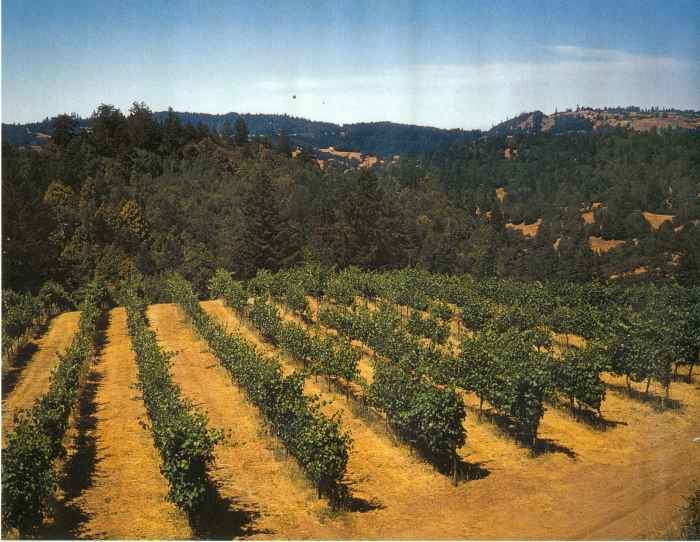 The Charles Ranch was adjacent the Bohan property on Bohan-Dillon Road and was once one of the largest sheep ranches in Sonoma County, at one point running a herd of 5,000 sheep (www.everyvine.com). It was settled by the Dillon and Charles families, settlers from Pennsylvania. The Dillons are Regina Martinelli's family (Regina is the EVP of Martinelli Winery in Windsor). The Dillon/Charles family raised sheep through six generations for over 130 years after acquiring the land during the Homestead Act in 1860. George H. Charles, a fourth generation rancher and Regina's grandfather, eventually found sheep ranching unprofitable as laws were passed favoring the preservation of coyotes who then devastated the sheep herds. George’s son-in-law, Lee Martinelli, Sr., who had been visiting George at his ranch since 1958, was a successful winegrower who had taken over management of his Uncle Toni Bondi’s estate in the Russian River Valley in 1973. In 1980, he suggested that George plant grapes, and with his assistance, George planted a 14- acre Chardonnay vineyard on a former sheep pasture at 977 feet elevation (Charles Vineyard). This was the second planting of wine grapes in the area after Mick Bohan. George would lease the vineyard to Lee Martinelli, Jr., in 1988. Lee Martinelli, Sr., first met Helen Turley by happenstance on a visit to Cazadero. Her Marcassin Vineyard, planted on land purchased in 1985, was on the same ridge as David Hirsch’s property. That meeting led to a long working relationship between the Martinelli family and Helen Turley and her spouse John Wetlaufer. Turley and Wetlaufer worked with the Martinellis in planting and farming their vineyards as well as making wine for the Martinelli Winery which was founded in Windsor in 1987. Together, they established Blue Slide Ridge Vineyard and Four Sisters Vineyard, both of which are on the original Charles property, and nearby Marcassin Vineyard. Perhaps the least known wine pioneers in the West Sonoma Coast were Tim Schmidt and Dan Wickham of Sea Ridge Winery. Yet, it was the Pinot Noir they produced in the early 1980s at their rudimentary winery (the first to be located in the far Sonoma Coast) that initially brought attention to the region as possessing the potential for producing world-class Pinot Noir. Jerry D. Mead, writing in Mead on Wine (“Wines From Fort Ross?, News Herald, April 16, 1985) said, “Sea Ridge Winery....is only the vanguard for what I predict will become the most important new appellation for producing Burgundian grape varieties in the United States. With the exception of the Santa Cruz Mountains and some parts of Oregon, I can think of no region so promising for Pinot Noir, and that includes Carneros.” Nearly 30 years later, Mead’s proclamation has come true. Tim Schmidt and Dan Wickham were both marine biologists working at the University of California at Berkeley Bodega Bay Marine Laboratory when they met in 1974. They began making wine at home together the following year. Schmidt was born in Santa Rosa and his love for the sea led him to pursue a bachelor’s degree 9 in botany from University of California at Berkeley and a master’s degree in zoology at the University of Canterbury in Christchurch, New Zealand, in 1973. Wickham was a native of Michigan who made his first wine at age 10. After coming to California, he earned a PhD from University of California at Berkeley, studying the collapse of Dungeness crab fishing. He made a Cabernet Sauvignon in 1974 that took a gold medal in a Wine and the People competition and won praise from Andre Tschelistcheff. His winemaking experience led him to become the winemaker at Sea Ridge Winery while Schmidt became the business manager. Their spouses, Susie Avant Schmidt and Dee Hagberg Wickham also played a role in marketing the wines and managing the brand. Schmidt and Wickham borrowed money from family members and acquired a remote 40-acre ridge top property 3 miles inland as the crow flies from Fort Ross and twelve miles west of the town of Cazadero in 1979. See pages 12, 13 and 14 for maps. The site was 1,100 feet above sea level above the fog line. The land was part of the old Seaview Ranch so the name they chose for the winery was geographically connected. Historically, a ship captain, Captain Seyveldt, homesteaded the land and in 1910 planted a pear orchard. He was murdered in 1940 for his supposed treasure which was thought to be buried on the land but was never found. Both partners loved Burgundy wines and their backgrounds convinced them that the limestone-based shale soils and cool coastal climate of the Sonoma Coast were perfect for Burgundy varieties. Wickham told Wines & Vines (72:9, 1991) “It combined all the best aspects of soil and climate to be found in California with all the worst aspects of trying to run a business in a remote wilderness.” After choosing the site, they built a 3,000- square-foot winery, doing all the construction themselves, and bonded it in 1980 for 5,000 cases. Schmidt left his job initially to run the winery while Wickham continued as a consultant for the Marine Laboratory. Initially, they produced “Sonoma County” Pinot Noir from purchased fruit. The first crush was in 1980 with Pinot Noir grapes purchased from neighbor Michael Bohan. Wickham remarked, “One of the finest Pinots I have ever tasted.” Their 1981 Sea Ridge Bohan Vineyard Sonoma County Pinot Noir ($10.50) won a Gold Medal at the 1984 Sonoma County Harvest Fair. A photo of the award, shown to me at WOW by David Hirsch:
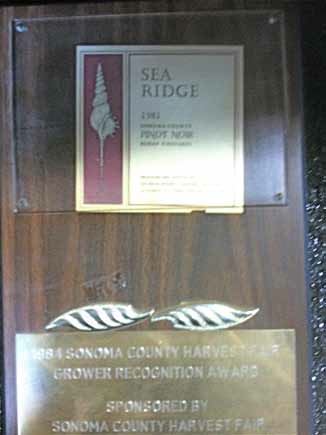 The award is a remarkable achievement in that the wine was produced in a sparse winery that had no electricity and water was very precious. The grapes were pressed using an ancient basket press from a friend’s grandfather. In 1982, Wickham found better winemaking equipment but he ended up personally handling, crushing, transporting and cleaning up a crush of over 80 tons of grapes because his partner had a broken arm (Wines & Vines, 9:72, 1991) An old generator was acquired by 1982, and electricity arrived in 1986. The Pinot Noirs were fermented in open top containers with twice daily cap punch downs and were aged in 60-gallon French oak barrels. Grapes were de-stemmed with the inclusion of 5% to 15% whole cluster. Their 1981 Sea Ridge Sonoma County Pinot Noir ($9.75) won multiple silver and bronze awards in competitions, as did the 1982 Sonoma County Pinot Noir ($10.50). They also produced a Zinfandel from Porter-Bass Vineyard in 1982 ($8), 20 cases of sparkling wine from Mill Station Vineyard Chardonnay in 1982, a Chardonnay in 1983 from Mill Station Vineyard, and a 1984 Sauvignon Blanc. The Sauvignon Blanc grapes came from outside the region and that wine was discontinued to concentrate on Pinot Noir, Zinfandel, a Rustic Red proprietary wine (Zinfandel and Petite Sirah from Bohan Vineyard), Riesling (from Hirsch Vineyard), and several Chardonnays including bottlings from Hillcrest Vineyard near Occidental, Mill Station Vineyard near Sebastopol, and Porter-Bass Vineyard. The 1983 Sea Ridge Sonoma County Pinot Noir ($11.50) was composed of 60% Bohan Vineyard fruit and 40% of grapes from a vineyard near Forestville. In subsequent vintages, Hirsch Vineyard also supplied a significant amount of Pinot Noir fruit. Sea Ridge Winery was the first to use the Hirsch Vineyards name on a bottle of wine, with the first single vineyard Pinot Noir produced in 1989 sourced completely from Hirsch Vineyard. A 1983 Sea Ridge “Coastal Selection” was a reserve bottling in which a small portion of the best grapes from coastal ridges were included (Summa Vineyard located near Occidental was one of the sources). By 1985, production had reached a few thousand cases. In the Sea Ridge Winery Newsletter (1:3, Fall 1987) it was noted that after the Sonoma Coast AVA was approved in 1987, the Sea Ridge Winery future releases would bear the new appellation “Sonoma Coast” instead of Sonoma County. Also, the labels began using the term, “Table Wine,” instead of alcohol percentage which was often between 12% and 13%. The owners said, “We consider wine both a wonderful, healthful beverage and food. It’s not a liquor, so we do not see why we should dwell on the alcohol it contains.” Wine writers fawned over the Pinot Noirs. Dan Berger said, “The taste is silky and warm....delicate in the mouth....very Burgundian in aromas....wines well made....winery worth seeking out. Robert Parker, Jr., noted, “I was extremely impressed with the lush, delicate, silky flavors reminiscent of Domaine Dujac....spicy, intensely perfumed. Jerry Mead said, “Superior wines in every regard....very intense cherry and berry flavors, very complex and long....a Best Buy.” Mead noted in 1985 (News Herald, “Wines-From Fort Ross?,” April 16, 1985), “The Pinot Noirs are light in color, extraction and body, but flavorful.” Tim Tesconi wrote, “The wines are to be praised for fruitiness, finesse and delicate balance.” (The Press Democrat, “Sea Ridge: Prize-winning wine amidst the redwoods,” March 25,1985) The Sea Ridge label had a drawing of a marine snail called Tibia fusus drawn by a local artist. This snail is found in the Southern Pacific living burrowed in sand and uses its long spine as a funnel to extend a siphon into the water above. The gastropod feeds, like clams, by siphoning a stream of water into its body, from which it filters out tiny planktonic particles. The Sea Ridge owners chose Tibia as a mascot since they felt its delicate elegance was reflected in Sea Ridge wines. Early on, visits to the winery were by appointment only, but a tasting room was established in 1986 that was open daily in Bodega Bay near The Tides Wharf on Highway 1. The tasting room was quite an attraction with its aquarium seascapes and led to a full write-up in The Press Democrat (“It’s more than a tasting room,” Bob Norberg, August 8, 1986). At some point in the 1980s, a Pinot Noir vineyard was planted on the Sea Ridge property and named Seaview Vineyard. The cuttings for the vineyard came from Summa Vineyard that was located on a ridge top on Taylor Lane west of Occidental first planted in 1979. Writer Tim Tesconi (The Press Democrat, “Sea Ridge: Prizewinning wine amidst the redwoods,” March 25,1985) described Seaview Vineyards as “8 acres of Pinot Noir surrounded by redwood groves.” Reportedly, the vineyard had many challenges, including wild pigs who knocked down fences and allowed deer, rabbits and sheep to get in. Reportedly, a lack of water ultimately led to the death of the vineyard. This is curious since the region has very high annual rainfall and the Sea Ridge property had springs on it. My research did not uncover any further specifics about the Seaview Vineyard except that David Hirsch told me, "I am not sure the owners ever harvested grapes from that vineyard and the vineyard is no longer in existence.” John Haeger (North American Pinot Noir, 2004) reported that Helen Turley “became involved with the declining Sea Ridge Winery,” but I don’t know the details. The wines crafted during the early years of the winery were most successful. In 1988, the partners had a falling out over differing philosophies and Wickham bought out Schmidt. Wines & Vines (9:72, 1991) reported the details. Wickham retained the Sea Ridge label and stocks of Sea Ridge wine, and Schmidt held onto the Cazadero property and the Seaview Vineyards. Wickham was joined by a new partner, Dick Hagberg of Santa Rosa, and they leased a historic winery facility in Occidental that had been built in 1903 by Lee Morelli and operated as the Lemorel Winery until the 1960s. The winery, which was the oldest in West Sonoma County, was on 60 acres of vineyard land owned by Robert von Wiedlich who farmed Zinfandel and Merlot there. Wickham’s first crush in the new winery was 1989 with Zinfandel supplied by Wiedlich (in the Rustic Red blend), Chardonnay from Mill Station Vineyard, and Pinot Noir from Hirsch Vineyard. Dan and Dee Wickham were able to draw little salary from the Sea Ridge Winery operation and because of financial problems, lack of a successful marketing program, and other commitments, sold Sea Ridge Winery after 15 years, turning over the winery facility to Eric Ross Winery. The Sea Ridge Winery name was picked up by the Bronco Wine Co. who currently produce a line of California appellation varietals under that label. On the 10th anniversary of the winery, Wickham wrote the following in the Fall 1990 Sea Ridge Winery Newsletter. “Ten years ago I knew deep in my bones that the Sonoma Coast was special. The ‘experts’ said it was ‘too cold.’ After a decade of experimentation I now know the experts were wrong! I remember being stunned that very first vintage in 1980 when we got pinot noir from this supposed ‘Artic’ region at over 25º Brix. And they also had remarkable natural acids and deep fruit, producing balanced wines against the odds. Then 1981 became the earliest vintage ever. The result was a gold medal Pinot Noir only to be followed by 1982 with the latest vintage on record.” The story of Sea Ridge Winery exemplifies the many challenges encountered growing wine grapes and producing wine in the rugged and remote West Sonoma Coast. Nevertheless, the notoriety of Sea Ridge Winery Pinot Noir created a belief that the finest California Pinot Noir and Chardonnay might be grown along the westernmost coastal zone of the continent, and today, that belief is becoming a reality as many others pursue plantings in the West Sonoma Coast. Some additional historical documents are reproduced on the following pages. The first is the original label from the first Sea Ridge Sonoma County Pinot Noir and a map; this is from the first brochure produced by the winery. The second page shows a map produced by Sea Ridge Winery with directions to the winery. The third page shows a vast map of much of the Russian River Valley and Sonoma Coast showing the location of Sea Ridge Winery in perspective.
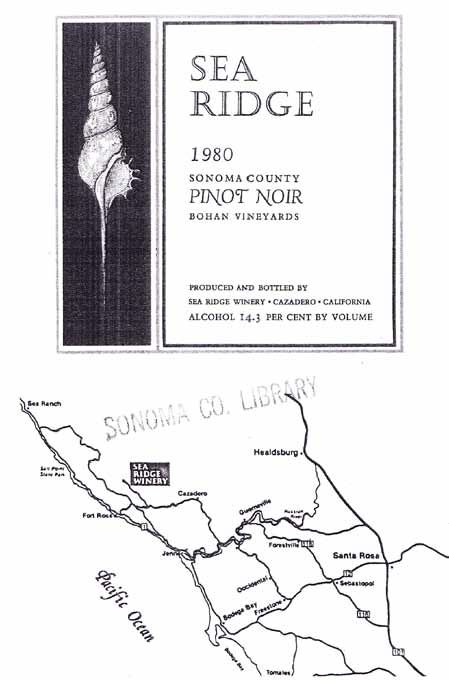
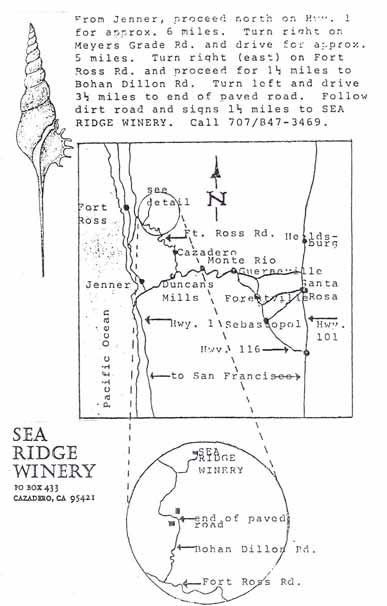
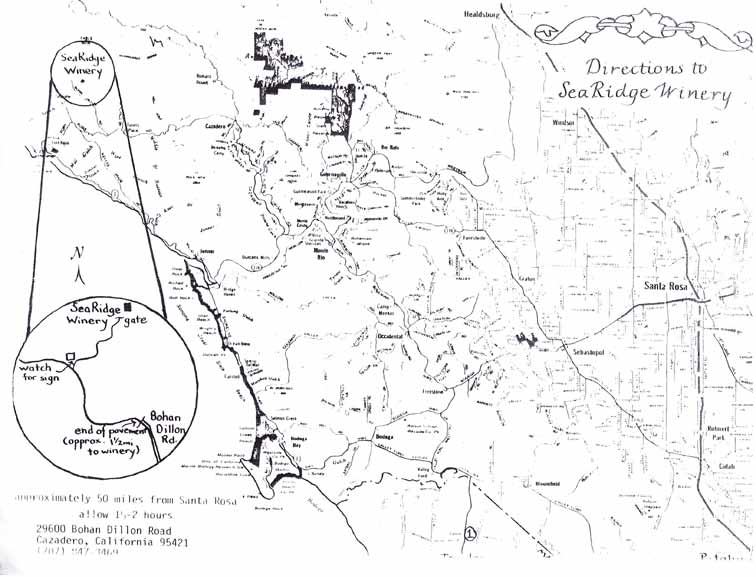
Part III: Fort Ross-Seaview AVA TodayFort Ross-Seaview consists of 27,500 acres contained entirely within the large Sonoma Coast AVA and does not overlap any other viticultural area. The formal petition calling for AVA approval was presented in 2003 by Patrick Shabram, a consulting geographer and Linda Schwartz of Fort Ross Vineyard & Winery and David Hirsch of Hirsch Vineyards, but not approved until January 2012. This was due to various opinions on boundaries, whether to include Annapolis to the North, and what the new AVA would be called. Hirsch notes that 18 different growers were involved in penning the petition.
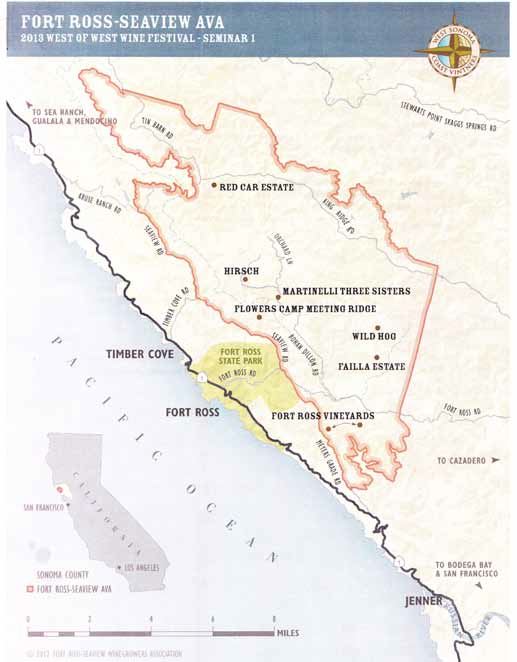 The distinguishing feature of the Fort Ross-Seaview AVA is that most vineyards are located along the Pacific coastline on ridge tops that form islands in the sky at elevations between 920 and 1,800 feet above sea level. This puts them above the natural fog line, but close to the Pacific Ocean, creating a moderate climate of “cool sunshine.” Unlike most of California where vineyards are planted on valley floors and some hillsides in alluvial soils, vineyards in the Fort Ross-Seaview AVA are on hilltops flanked by gullies and narrow valleys and amongst dense redwood forests. The San Andreas Fault runs right through the region and created the convoluted topography. There are many soil types, but sedimentary rock, sandstone and shale prevail. David Hirsch pointed out that the Fort Ross-Seaview area, at least where he is located, is a confluence of four ecosystems, making the region particularly unique: the ocean, the rivers, the redwood forest and the ridge tops. The nearby Pacific Ocean helps to keep the vineyard temperatures from rising or falling to extremes. The rivers in the gullies play a complimentary role, helping to cool the ridge tops in the heat as well as drawing cool air downward in the cold to negate the threat of frost. The redwood forests are essentially a rainforest, while the ridge tops have a continental climate. When weather systems arrive from the Southeast, vineyards above 900 feet elevation have longer periods of sunlight and more warmth than the land below with the temperature reaching into the 90s, and even into triple digits on occasion. Pinot Noir and Chardonnay are the most common varieties grown in the Fort Ross-Seaview AVA with small amounts of Zinfandel, Petite Sirah, Syrah, Pinotage, Viognier, Marsanne and Roussane. There are 18 commercial vineyards on 506 acres. Wineries located within the Fort Ross-Seaview AVA: Flowers Vineyards & Winery, Hirsch Vineyards, Peay Vineyards, and Wild Hog Vineyard. Additional vineyards in the Fort Ross-Seaview AVA: Aston Estate (Boar’s View Vineyard), Blue Slide Ridge Vineyard (Martinelli), Bohan Vineyard, Charles Vineyard (Martinelli), Failla (Estate Vineyard), Cinghiale Vineyard (Del Dotto) Fort Ross Vineyard (Fort Ross Vineyard & Winery), Hellenthal Vineyard, Marcassin (Marcassin Vineyard), Nobles Vineyard, McDougall Ranch Vineyard, Pahlmeyer (Wayfarer Vineyard), Seaview Vineyards (Peter Michael), Precious Mountain Vineyard, Red Car (Estate Vineyard) and Three Sisters Vineyard (Martinelli) Wineries that are located outside the Fort Ross-Seaview AVA but purchase grapes there: Benovia, Bjornstad Cellars, B. Kosuge Wines, Davies, Del Dotto, Drew, Dutton-Goldfield, Freeman Vineyard & Winery, Kutch Wines, LIOCO, Littorai, Morlet Family Vineyards, Siduri, Williams Selyem, WesMar Winery, and W.H. Smith Wines.
Part IV: Tasting Pinot Noir from the Fort Ross-Seaview AVA
David Hirsch talked about the two vintages offered for tasting in the Fort Ross-Seaview AVA. 2010 was very challenging and he likened it to an unruly adolescent who was hard to manage. The winter was rainy and total rainfall was over 100 inches, but that was not particularly unusual as heavy rainfall is customary for the area. What distinguished 2010 was the long periods of cool weather during the spring and summer, with overcast skies, fog and biting winds. The result was an uneven crop set and extensive millerandage making farming for balance daunting. Two inches of rain preceded harvest and after the first few days of harvest, temperatures shot up into the 90 degree range causing the fruit to become quickly ripe all at once. The 2011 vintage in contrast was a “rocking chair vintage” in that the summer temperatures were very consistent, with only one day reaching 90 degrees. It was a vintage growers could sit back in a chair on their deck, look out over the vineyard, and let nature take its course. All wines underwent native primary fermentation and malolactic fermentation, except the Martinelli bottling which was vinified with inoculated malolactic fermentation (information on Wild Hog bottling not available).
North
2011 Red Car Estate Vineyard Sonoma Coast Pinot Noir 13.5% alc., pH 3.79, TA 0.522. 900-1000 feet elevation, southeast aspect, 3-10% slope, Calera, 828 and 777 clones on 420A rootstock, Ohlson Ranch sandstone soils. Average Brix 22.7º, 10% whole cluster, aged 14 months in 29% new French oak. · Moderately dark reddish-purple color in the glass. Very shy nose but very appealing core of vivid dark fruits, a silky texture, admirable balance, and very good finishing fruit intensity. Should be marvelous in another year.
Central
2011 Flowers Camp Meeting Ridge Estate Sonoma Coast Pinot Noir 12.8% alc., pH 3.60. 1150-1400 feet elevation, northeast aspect, 5-37% slope, Swan, Pommard, 114,115 and 2A clones, 3309 rootstock, tight 3.33 x 3.33 spacing, Hugo Atwell Complex soils. Average Brix 21.7º, 25% whole cluster, aged 15 months in 25% new French oak. · Moderately light reddish-purple color in the glass. Nicely perfumed with dark red fruits and spice. Very flavorful and savory with good acidity appealing texture and impeccable balance. An exceptional wine that is still young.
2010 Hirsch Vineyards “San Andreas Fault” Estate Sonoma Coast Pinot Noir 13.0% alc., pH 3.57, TA 0.57. 1300 feet elevation on average, various aspects, 0-45% slope, Pommard, Mt Eden, Swan 114 and 777 clones, various rootstocks, various soils. Average Brix 22.9º, 100% de-stemmed, aged 18 months in 35% new French oak. · Moderately light reddish-purple color in the glass. The nose is closed for business. Delicate flavors of cherries and cranberries with briar-themed oak in the background. Noticeable tannins with a smooth mouth feel and short finish.
2010 Martinelli Three Sisters Vineyard Sonoma Coast Pinot Noir 14.5% alc., pH 3.85, TA 0.59. 1100 feet elevation on average, south and east aspect, 0-35% slope, clones Pommard, 115 and 777 on 101-14 and 3309 rootstocks, Josephine and Goldridge soils. Average Brix 23.8º, 100% whole cluster, aged 10 months in 57% new French oak. · Moderately dark reddish-purple color in the glass. Effusive aromas of black cherries and black raspberries with generous notes of toasty oak. Oak-dominated core of plush, sappy dark red and black fruits with a highly seductive, velvety mouth feel. Very ripe in character. Alcohol peaks out on the finish.
South
2011 Fort Ross Vineyard “Sea Slopes” Sonoma Coast Pinot Noir 13.0% alc., pH 3.71, TA 0.59. 1250 to 1750 feet elevation, southwest aspect, 5-30% slope, Calera, Pommard, Swan, 115 and 777 clones on 101.14, 3309, 110R and 420A rootstocks, various clay and sandy clay loam soils. Average Brix 22º, 5% whole cluster, aged 10 months in 20% new French oak. · Moderately light reddish-purple color in the glass. Shy aromas of red fruits. Crisp and lean, featuring flavors of red cherries, pomegranate and cranberries with a touch of spice. Soft tannins make for easy drinking. Could pick up intensity over time in bottle.
2011 Failla Estate Vineyard Sonoma Coast Pinot Noir 13.45% alc., pH 3.85, TA 0.55. Southeast aspect, clones 777, Swan and Calera, 101.14 rootstock, Franciscan Complex soil. Average Brix 23.5º, 20% whole cluster, aged 12 months in 30% new French oak. · Medium reddish-purple color in the glass. Deep, dark fruit is the theme on the nose and palate. Juicy, with good acidity, balanced tannins and a generous finish. Picks up a spicy, savory bent over time.
2010 Wild Hog Vineyard Estate Sonoma Coast Pinot Noir 14.0% alc., no other information available. · Dark reddish-purple color in the glass. Aromas of dark stone fruits and nuts. Juicy and crisp on the palate, with a middleweight core of oakkissed black fruits, grainy tannins, and a brooding finish. Still a bit tight and disorganized.
There were 36 participating wineries pouring at the WOW Grand Tasting. A number of the wines being offered I had already reviewed so they were not re-tasted. I did not taste every wine as I was having too much fun talking Pinot, chatting with old acquaintances and making new friends, but I have listed below the wines that really caught my attention when I did some serious tasting. None of these wines are inexpensive because of the high farming costs, but they are at the top echelon of California Pinot Noir being produced today. The venue at The Barlow in Sebastopol was perfect for the WOW event. The Grand Tasting was held outdoors inside a tent on grass. Attendance was significant but the winery tables were easily accessible to the eager pinotphiles. There was a good buzz of excitement and I thoroughly enjoyed myself. The highlight of my day came when I met Tom Dehlinger for the first time!
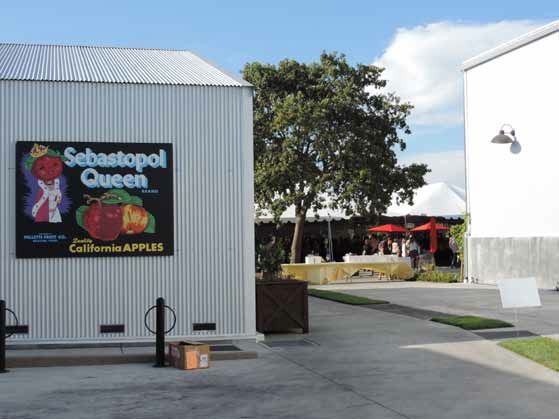 Outstanding 2011 Benziger Family Winery de Coelo Quintus Sonoma Coast Pinot Noir 13.0% alc., pH 3.64, TA 0.63, $75. 25-acre Biodynamic® estate vineyard. Quintus and Terra Neuma are two distinctive blocks. 2011 Gros Ventre Cellars “First Born” Sonoma Coast Pinot Noir 2011 LaRue Wines Sonoma Coast Pinot Noir 150 cases, $68. 17 months in 33% new French oak. 19 2011 Littorai The Pivot Sonoma Coast Pinot Noir Ted Lemon’s estate vineyard adjacent the winery. 2011 Littorai Hirsch Vineyard Sonoma Coast Pinot Noir 2010 Pahlmeyer Sonoma Coast Pinot Noir Wayfarer and Hallberg vineyards. Winemaker Erin Green’s last vintage at Pahlmeyer. Newest winemaker for Sonoma Coast wine is Bibiana González Rave. 2011 Soliste Nouveau Monde Sonoma Coast Pinot Noir 79 cases, $75. Pommard clone. The Soliste team below (co-owners Claude Koeberle left and Don Plumley right, and winemaker Ryan Zepaltas center)
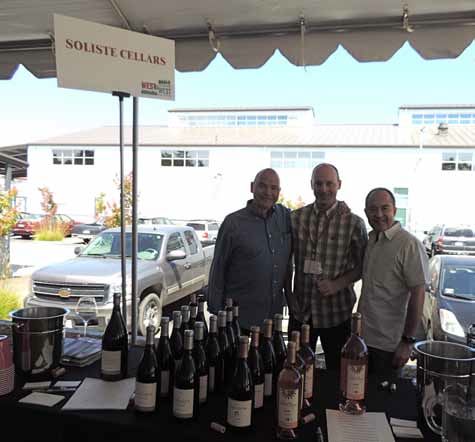 Very Good 2010 32 Winds Wine Hirsch Vineyard Sonoma Coast Pinot Noir Winemaker Ehren Jordan. 2012 Benovia Tilton Hill Sonoma Coast Pinot Noir Barrel sample, Calera and 943 clones. 2011 Benziger Family Winery de Coelo Terra Neuva Sonoma Coast Pinot Noir 2011 Failla Occidental Ridge Sonoma Coast Pinot Noir 2011 Failla Hirsch Vineyard Sonoma Coast Pinot Noir 2011 Gros Ventre Cellars Campbell Ranch Vineyard Sonoma Coast Pinot Noir 2010 LaRue Wines Sonoma Coast Pinot Noir 2011 LIOCO Wine Co. Hirsch Vineyard Sonoma Coast Pinot Noir 2012 MacPhail Family Wines Markydian Vineyard Estate Sonoma Coast Pinot Noir Barrel sample. 2010 Sonoma Coast Vineyards Bodega Ridge Sonoma Coast Pinot Noir 2011 Zepaltas Devoto Vineyard Sonoma Coast Pinot Noir Magnum Other winery participants at WOW worth your consideration: Baker Lane Vineyards, Banshee Wines, Ceritas Wine, Cobb Wines, Emeritus Vineyard, Freeman Vineyard & Winery, Halleck Vineyard, Hartford Family Winery, Joseph Phelps Vineyards, Lattanzio Wines, Marimar Estate Vineyards & Winery, Patz & Hall Wine Co., Paul Hobbs Winery, Peay Vineyards, Ramey Wine Cellars, Red Car Wine Company, Small Vines Wines, Siduri, and Sojourn Cellars. Can I say anything definitive about a commonality of style and character of the wines of West Sonoma Coast or more specifically, the Fort Ross-Seaview AVA? In a word, no, although some general comments can be made beyond the fact that the wines from thus region are consistently superb from all producers when vintage conditions cooperate. Moderator Jon Booné spoke about “brooding minerality” as a trait the wines share, but I have no idea what that means. The cool climate in the West Sonoma Coast leads to small berry size with higher juice-to-skin ratios which produces concentrated fruit flavors. Because of the low temperatures, grapes ripen slowly and develop mature phenolics often before acquiring sugar ripeness so the grapes may be picked at relatively low Brix. As a result, acidity is usually high and alcohol levels on the low to moderate side. The comments in the past of Ted Lemon, “Muscle and sinew, grit, structure, more backbone and tannin than Russian River Valley Pinot Noir; spicy and peppery in leaner years with sage and savory as the prominent spices, and dark fruits in riper vintages,” and Andy Peay, “Higher acidity, sturdier tannins, less ‘gobs’ of fruitiness, and more tertiary flavors like earth, minerals, tea and forest floor” provide the best descriptors, albeit broad and simplified, of Pinot Noir from the West Sonoma Coast. One parting comment from WOW: The 2011 vintage was highly successful for West Sonoma Coast vintners. Serious pinotphiles should seek out these wines NOW as production is limited. In particular, based on my tasting at the WOW Grand Tasting, buy every wine you can get your hands on sourced from Hirsch Vineyards. (photo below)
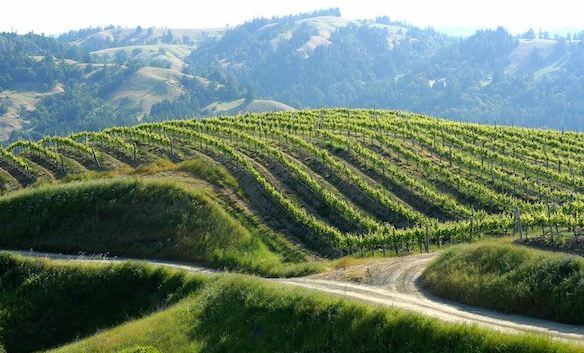 One additional comment about the site of WOW, The Barlow complex in downtown Sebastopol. The former Barlow Apple Factory (the Barlow family started the first commercial applesauce business in the United States before going out of business in 2004) has been reinvented to showcase both production and retail for artisan producers and is the first of its kind in the country. It allows an environment where a concentrated group of artists, craftspeople, food and wine artisans can connect, socialize and market. The 220,000-square-foot Barlow complex has parks, gardens, an event center, bocce ball courts, children’s play areas, and the Sebastopol farmer’s market. The new project is tastefully designed with buildings constructed of corrugated metal to duplicate in a modern fashion the look of the historic apple processing plant. The Barlow complex includes two wineries, Kosta Browne Winery (not open to the public) and Wind Gap Wines. There are several winery tasting rooms including LaFollette Wines, MacPhail Family Wines, and Marimar Estate Vineyards & Winery. The Woodfour Brewing Company, Warped Brewing Company and the Spirit Works Distillery are tenants. Russian River Valley’s iconic restaurant, Zazu Kitchen + Farm has moved into the Barlow complex from their previous roadside location in Santa Rosa. Owners Duskie Estes and John Stewart have the title of “King and Queen of Porc.” Noted chefs Claude Koeberle and Thomas Keller of the French Laundry have something in the works as well. Businesses will continue to open through the fall of 2013. Preliminary approval has been obtained for a 60-room boutique hotel on the property that could be open by the summer of 2014. This hotel and The Barlow will draw tourists to Sebastopol, which has many famous wineries within the city limits or nearby, but has only two small hotels, and has never had the allure of Healdsburg which is a 30 minute drive to the North. Sebastopol, however, is much more synonymous with Pinot Noir than Healdsburg. The photos to follow give you a feeling for the ambiance of the complex.
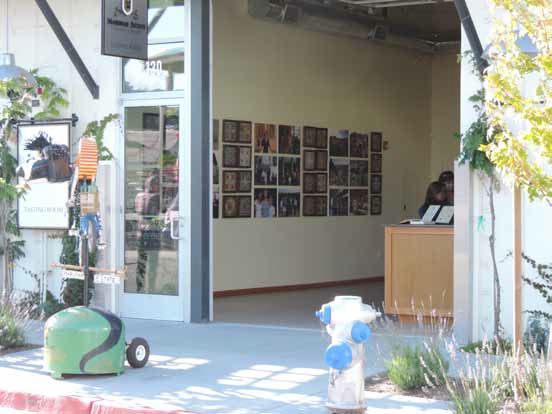
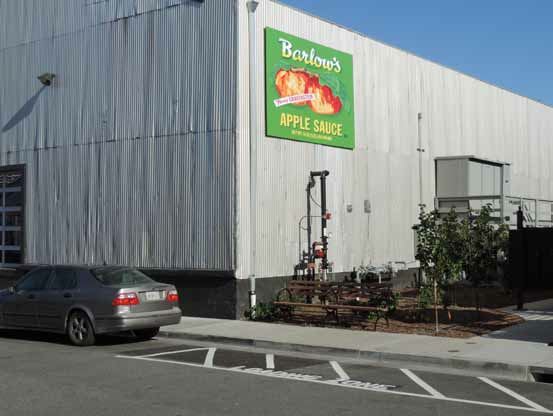
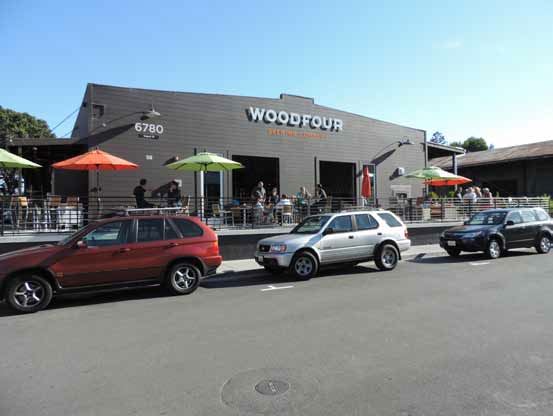
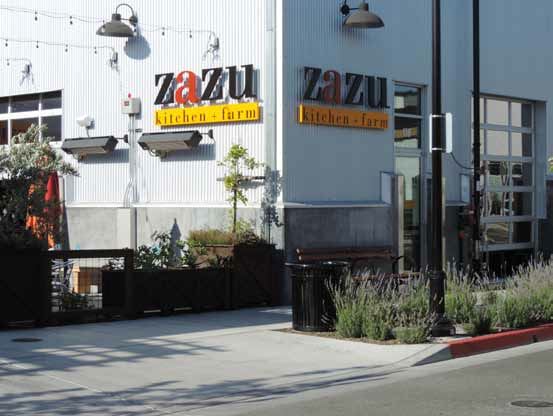
Scratch Wines: Risky BusinessSabrine M. Rodems is a winemaker and owner of Scratch Wines as well as the media contact for a group of independent winemakers who have joined forces to promote their small wine brands to the trade and media under the name of “Wines of Danger.” This loose affiliation of professional winemakers make wines that are anything but safe, thus the name. Some members have day jobs working for established wine brands and some do their label full time. Either way, the group of 20 vintners is emboldened with unfiltered exuberance and highly aromatic naiveté. The first media and trade tasting of “Wines of Danger” will be held August 12 at The Press Club in San Francisco. For more information, visit www.winesofdanger.com.
 Sabrine is the youngest of six and growing up in Novato, which was practically a cow town in the late 1960s and 1970s, the family did everything that was free: winery tours, cheese factory tours, chicken farm tours, and plenty of camping. She says that she went on more tours by the time she was seven than most people do in their entire lives. The memories stayed with her and left quite an impression. Sabrine has a Bachelor of Arts degree in Theater, Film and Television from the University of California at Los Angeles. After graduating in June 1992, she spent the next decade as a prop builder for stage and screen. In the late 1990s, she went back to college and was considering entering the medical field, but her sister, a family doctor, jokingly told her, “We don’t need another doctor in the family, we need an enologist in the family.” Sabrine felt that her sister envied her because she worked in the arts, while Sabrine envied her sister who was versed in science. Both of them grew up with a passion for food and wine, and since Sabrine wanted to pursue a career that combined art and science, she decided to transfer her pre-med course work and obtain a Master of Science degree in Viticulture and Enology from the University of California at Davis. She accomplished her goal in 2004. Upon graduation from Davis, she joined San Saba Vineyard and was promoted to winemaker within two years. In 2008, when the Thomas Family purchased San Saba Vineyard, the Wrath label was created. She continued to craft wine for Wrath’s owners Michael and Barbara Thomas, but with their blessing and support, began her own personal wine project in 2011, Scratch Wines.
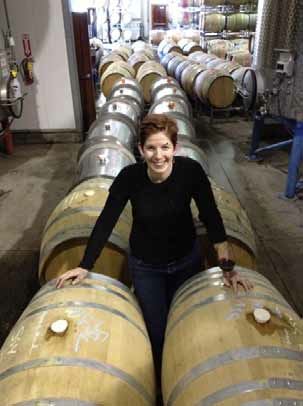 Sabrine told me, “Scratch is a brand I created to push my limits. My objective is to pick grape varieties I love and make them in styles that show them off at their best: high acid Riesling, spicy Grenache and bold Pinot Noir. I also wanted to push the boundaries of art. My brand is about art, the art of wine and the art on the label. My brother-in-law, who is a Humanities professor at University of California at San Diego by day, and whose tag is Neun, is a spray paint artist at night who does some provocative work that I was immediately drawn to for my label art. He only works in his garage, so no illegal work, but I think it is amazing.” Having tasted Riesling and Grenache from the Arroyo Seco, Sabrine was always impressed with the wines. The rocky soil of the dry river bed really lends itself to these varietals. When she tastes her Riesling and other Rieslings from here, she thinks of the river rocks. The Grenache from the Arroyo Seco is very spicy and the significant whole cluster really pushes the spice and dark fruit forward. The Pinot Noir from KW Ranch has plenty of rich fruit flavors with the addition of structure and flavor contributed by whole cluster creating a very complex glass of wine. She is also looking to produce a Cabernet Sauvignon from the Santa Cruz Mountains for the 2013 harvest. Sabrine’s philosophy can be summed up by the following. “Scratch is really a passion brand for me. I get to do what I want to do and how I want to do it. I printed the raw data on the back of my labels because I want people to understand what it means and what the style is going to be like without flowery language. I’d like to think that without being myopic, I can successfully use my experience as a barometer, and I think wine consumers will appreciate my wines and their presentation. Not to say it is not without risk. In fact, it is laden with risk. Maybe that is what I like about it.” This made me think of the tagline for the Tom Cruise movie, Risky Business, “There’s a time for playing it safe and a time for Risky Business.” The image on the Scratch label is a half of a girl’s face with a gas mask and the wine packaging is very appealing. Scratch wines are sold through the website at www.scratchwines.com and by a few Northern California retailers (Napa Valley Wine and soon Russian River Wine Co.). Production will increase with the 2012 vintage when about 200 cases of each varietal will be available. 831-222-0620.
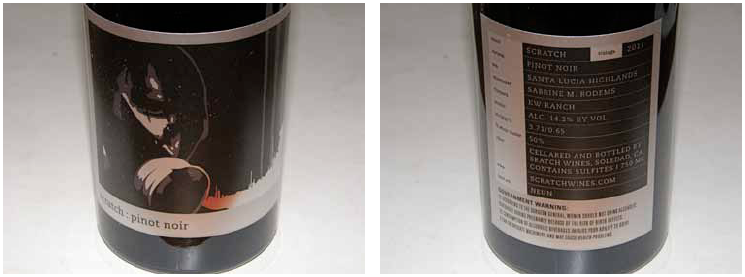
2011 scratch KW Ranch Santa Lucia Highlands Pinot Noir 14.2% alc., pH 3.71, TA 0.65, 35 cases, $45. Pommard 4 and 667 clones. 50% whole cluster. · Moderately dark reddish-purple color in the glass. Highly scented with aromas of darker berries, savory spices, rose petal and forest floor. Soft and enticing on the palate with a vivid array of dark red cherry and berry flavors that are well spiced and carry over with aplomb on the extended finish. The impeccable balance and drink ability is striking. Tasted later in the day from a previously opened and re-corked bottle, the wine was even more appealing. My wife was gaga over this wine and she is more picky about Pinot Noir than I. Score: 95
The 2011 scratch Ventana Vineyards Arroyo Seco Grenache (80 cases, $40) is vinified with 50% whole cluster in a Pinot Noir style that is appealing. It is a savory rendition of Grenache with herb, spice and floral aromas and flavors embellishing the core of juicy black cherry fruit. The 2011 scratch Ventana Vineyards Arroyo Seco Riesling (42 cases, $25) has a mineral-driven, lemon-lime and grilled pineapple theme with a good cut of acidity. It is bright, dry and crisp, goes down easy, and screams for oysters. Both wines are beautifully crafted.
J Vineyards & Winery: Varietal Wines with a SparkFor the past twenty-seven years, J Vineyards and Winery has built a reputation on sparkling wines, but the current and future success is predicated on a vibrant still varietal wine program. J began producing small lots of Pinot Noir in 1994 and Chardonnay in 1997, but it wasn’t until the 2007 vintage that J was transformed into a serious producer of varietal wines. The transition began with veteran winemaker George Bursick, and has flourished more recently under the direction of respected winemaker Melissa Stackhouse, who refined her varietal winemaking skills while head winemaker at La Crema for seven years. The transition was driven by the implementation of cutting-edge technological innovations for sub-soil mapping as new Russian River Valley vineyard lands were acquired and developed to upgrade and fine-tune vineyard sources. In addition, older, established estate vineyards, all of which are located in the Russian River Valley, were replanted with higher performing clones and rootstocks. Considering the success of J Cuvée sparkling wines, additional cool-climate vineyards in Sonoma County have become important sources of grapes for the varietal wine program. The popularity of the J California Pinot Gris program has led to the procurement of select fruit from Clarksburg and Monterey County to supplement the Sonoma County component. J Vineyards and Winery is the only winery in California that offers such a broad portfolio of sought-after, premium wines. Its state-of-the-art facility houses, in essence, two wineries under one roof - J sparkling wine and J varietal wines. The winemaking team implements separate and distinct winemaking protocols and equipment for each program. The winery (and estate vineyards) achieved “Certified Sustainable” status by the California Sustainable Winegrowing Alliance in 2012 Visit the beautifully appointed tasting room at 11447 Old Redwood Highway in Healdsburg for a range of tasting options. The website is www.jwine.com. The Pinot Gris, Vin Gris and Russian River Valley Pinot Noir are widely available in the retail market. The other wines are sold at the winery and to wine club members. The limited yields in Russian River Valley vineyards in 2011 prevented J from bottling vineyard-designated Pinot Noirs.
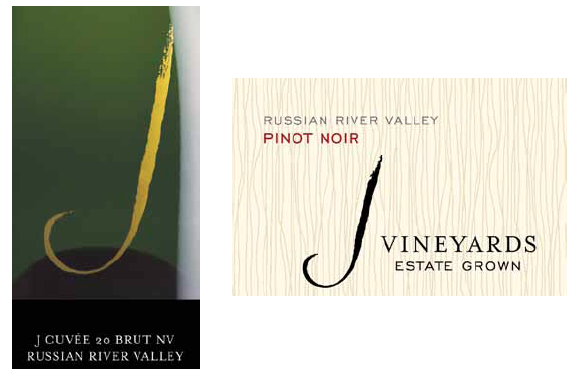
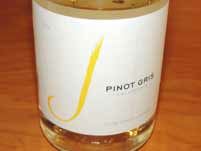 2012 J Vineyards California Pinot Gris 13.8% alc., pH 3.49, TA 0.58, 45,000 cases, $15, screwcap. Grapes sourced from Clarksburg, Russian River Valley, Lodi and Monterey. From an outstanding vintage, this wine was gently whole cluster pressed, fermented and cooled in stainless steel tanks to preserve freshness of fruit, and aged in stainless steel tanks. No malolactic fermentation. · Very pale golden yellow and clear in the glass. Bursting with aromas of tropical fruits, peach and orange peel with flavors of kiwi, lime, peach and honeycomb. Not a wimpy wine like so many Pinot Grigios, but rather showing good substance. Because it is crisp and refreshing, it can be enjoyed as a sipper when entertaining friends, but its acidity and complexity allow it to complement food rather than compete with it. An outstanding value widely available in the retail marketplace. Score: 89
2012 J Vineyards Estate Grown Russian River Valley Vin Gris 14.3% alc., pH 3.79, TA 0.50, 2,500 cases, $20, screwcap. Made by the French saignée method. After a cold soak, 10% of the juice was bled from open top fermenters. The drained juice was fermented and cooled in stainless steel tanks and aged in chilled stainless steel tanks. No malolactic fermentation. · Light pink coral color and clear in the glass. Aromas of strawberries, cherries, watermelon and white stone fruit echoed in the flavors. A hint of dried herbs on the finish adds interest. A delicate, even angelic wine, that is bracing and easy to drink. Score: 87
2010 J Vineyards Estate Grown Russian River Valley Pinot Meunier 14.2% alc., pH 3.61, TA 0.52, 120cases, $45. Sold at the winery and to club members. As a sparkling wine producer, it is not surprising that J has 3 acres of Pinot Meunier planted in Nicole’s Vineyard. Normally blended into the Cuvée 20, in 2010 a special varietal version for produced for limited release. 100% de-stemmed, fermented in Italian “Prospero” stainless steel tanks that allowed the seeds that fall to the bottom of the tank to be swept out. Aged 15 months in French oak barrels. · Medium reddish-purple color in the glass. Perfumed with aromas of dark red cherries and berries, spice, potpourri and oak. Middleweight flavors of dark berry fruits with an earthy bent. Soft in the mouth with a slightly rugged personality and noticeable oak in the background. An appealing wine for its individuality. A good alternative to Pinot Noir from Pinot Noir’s tom boy sister. Score: 89
2011 J Vineyards Estate Grown Russian River Valley Pinot Noir 14.3% alc., pH 3.82, TA 0.56, 7,000 cases, $37. From a cool, challenging vintage with limited yields. A blend from multiple sites in the Russian River Valley (Nicole’s, Robert Thomas and Nonny’s vineyards). Clones 113, 115, 777, 667 and 2A. 100% destemmed, fermented in 3-10 ton fermenters, then drained into tight-grain French oak barrels for 9 months (30% new). · Medium reddish-purple color in the glass. Shy aromas of cherries, peat, forest floor and sandalwood. Somewhat light but flavorful offering flavors of cherries, sage and cola with complimentary oak in the background. An easy drinker with suave tannins, a silky mouthfeel and a soft cherry themed finish. Score: 88
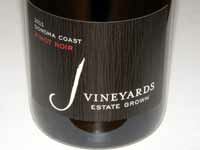 2011 J Vineyards Estate Grown Sonoma Coast Pinot Noir 14.4% alc., pH 3.69, TA 0.57, 625 cases, $55. From an eclectic mix of estate grown fruit including Robert Thomas Vineyard. Clones 777 and Pommard. 100% destemmed, whole berry fermentation in open top fermenters. Aged 12 months in 40% new French oak barrels. · Moderately dark reddish-purple color in the glass. I loved the nose on this wine which was bursting with aromas of blue and black berries and deep red roses. Fully ripe flavors of dark cherries, blueberries and black currants with an appealing conifer note. The fruit is quite showy on the mid palate and it finishes with good intensity. Tannins and acidity are in their place. Score: 91
2011 J Vineyards Estate Grown Barrel 17 Russian River Valley Pinot Noir 14.5% alc., pH 3.71, TA 0.52, 400 cases, $75. A winemaker selection to honor founder Judy Jordan’s estate vineyards, sourced exclusively from two Westside Road vineyards, Robert Thomas and Bow Tie. Clones 113, 115, 777, 667 and 2A. 100% de-stemmed, whole berry fermentation in open top fermenters, aged 12 months in 60% new French oak barrels. · Moderate reddish-purple color in the glass. The nose has plenty of Pinot character, offering the intense scent of Bing cherries, accented by briar, grilled mushrooms and oak. Very soft and seamless on the palate exhibiting layers of vivid black cherry and black raspberry fruit that finish with uncommon length. Very plush and velvety with unifying oak. Not as expressive now as it will be, yet this wine’s potential is obvious. Score: 94
Sips of Pinot Noir Tasted Recently
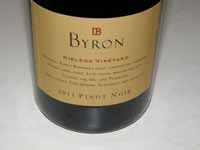 2011 Byron Nielson Vineyard Santa Maria Valley Pinot Noir 14.5% alc., $36. From Santa Barbara’s first commercial vineyard. Clones 114, 667 and Pommard. Small yields. · Moderately dark reddish-purple color in the glass. The aromatics are captivating with a complex array of black raspberry, blackberry, spice and floral aromas which hold up well over time in the glass. The dark red and black berry fruits are perfectly ripe and bright. There is a complimentary accent of spice and oak with an earthy undertow. This wine offers impressive clarity and tension and is very easy to drink now. I liked it increasingly over time. Score: 93
2011 CrossBarn by Paul Hobbs Sonoma Coast Pinot Noir 14.5% alc., $32. Native and select yeasts. Aged 11 months in 10% new French oak barrels. Unfined and unfiltered. · Moderately dark reddish-purple color in the glass. Ripe fruit profile on the nose featuring black cherry and raspberry with a hint of spice and charred oak. Soft in the mouth and easy to drink, with a flavorful mix of black cherry and black raspberry fruit. Nicely balanced with supple tannins and a complimentary note of oak in the background. Not particularly complex, but could be a workhorse at the nightly dinner table. Score: 86
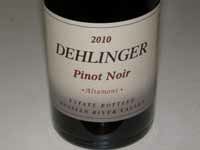 2010 Dehlinger Altamont Russian River Valley Pinot Noir 14.9% alc., 570 cases, $60. Yields on the estate’s 16 acres were very low in 2010. A combination of 20-year-old and 30-year-old vines. · Moderately dark reddish-purple color in the glass. Aromas of fresh crushed Bing cherries and baking spices draw you into the glass. Remarkable fullness of sappy, black cherry flavor on the middle palate with hints of cola and spice, carrying over to a generous, fruit-filled finish. Despite its concentration and structural bones, the wine is light on its feet and a delight to drink. The velvety soft texture is of the type that drives Pinot lovers mad. Beautifully composed and seamless in every way. Score: 96
2009 Fiddlehead Cellars Seven Twenty Eight Fiddlestix Vineyard Sta. Rita Hills Pinot Noir 14.1% alc., $42. Named for mile marker 728 on Santa Rosa Road. A cuvée of grapes from multiple parts of the vineyard. · Medium reddish-purple color in the glass. The nose delivers a pleasing message of fresh dark berries and spice. Very tasty essence of dark berry jam and plum reduction sauce on the palate complimented by new oak in the background. Nicely composed with balanced tannins and acidity, a seamless character, and a good finish. Ready to drink now. Score: 89
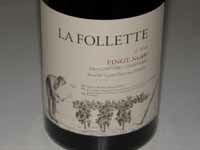 2011 La Follette Sangiacomo Vineyard Sonoma Coast Pinot Noir 12.9% alc., pH 3.58, TA 0.60, 536 cases,$ 40. Dijon 777, 114 and Swan clones grown in the Sangiacomo Vineyard located on Robert’s Road in the Petaluma Gap. Indigenous yeast, fermented in open-top, modified dairy tanks. Aged 10 months in French oak. · Medium garnet color in the glass. Deep cherry aromas with a note of savory herbs and prominent oak presence. Lovely core of dark cherry fruit with a touch of spice and plenty of oak. The wine is juicy, with soft tannins and some finishing intensity. Tasted the following day from a previously opened and re-corked bottle, the wine had transformed showing more fruit expression with much better integration of oak. I would decant this wine if you plan to drink now, or preferably, cellar it for another year to allow the oak to mitigate and the appealing fruit to elevate. Score: 90
 2011 Morlet Family Vineyards Coteaux Nobles Sonoma Coast Pinot Noir 14.5% alc., $59. From a hillside vineyard (Coteau) on an eastern slope (Cote) on the second ridge from the Pacific Ocean (Eaux). The Nobles family have farmed this land for four generations. The name then is Nobles Hillsides or Coteaux Nobles. Luc Morlet winemaker and proprietor. · Moderately dark reddish-purple color in the glass. Highly aromatic, offering inspirational aromas of fresh boysenberries and seasoned oak. Reasonably concentrated and quite delicious, with virile flavors of black cherries, black cherries and boysenberries. Beautifully put together with silky tannins and a lingering finish. Highly charming on the palate now, but could use more time in bottle for the aromas to catch up to the flavors. Score: 95
2011 Shea Wine Cellars Estate Willamette Valley Pinot Noir 13.0% alc., $37. An overall glimpse of the entire 200-acre vineyard including Pommard, Wädenswil and several Dijon clones. · Moderate reddish-purple color in the glass. Highly aromatic, picking up interest over time in the glass, offering aromas of Bing cherries, dark red cranberries and raspberries, with hints of spice, briar and oak. Delicate flavors echo the aromas. Some earthiness, but overall lacks nuance. Balanced tannins and a short, gentle finish. Pretty ordinary in this vintage. Score: 87
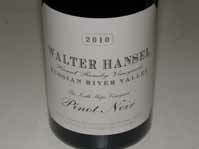 2010 Walter Hansel The South Slope Vineyard Russian River Valley Pinot Noir 14.8% alc., $39. · Medium reddish-purple color in the glass. Bing cherry aromas and flavors really jump out in this wine which has plenty of spice and cola to add interest. Soft in the mouth with plenty of typical rich, plush Russian River Valley fruit. Oak stays in the background and the tannins are nicely integrated. More body and spice than Tyra Banks on a Victoria’s Secret runway. Score: 92
13.5% alc., $36. · Moderate reddish-purple color in the glass. A challenge to pull any fruit from the nose which is dominated by oak-driven tobacco aromas. Relatively full-bodied and seductively textured, with a core of sappy black fruits currently buried in oak. The tannins are well integrated and their is a flash of appealing fruit on the lasting finish. This wine needs a year or two in bottle to integrate the oak. Score: 86
Pinot BriefsLoring & Cargasacchi Tasting Room Loring Wine Company & Cargassachi/Point Concepcion have partnered to open a tasting room located at 420 East Highway 246 between the Hitching Post II and Ostrich Land. The tasting room is open Thursday through Monday from 10:00 to 5:00, Tuesday or Wednesday by appointment only. Appointment needed for groups of six or more. 805-691-1300. Kosta Browne Winery Acquires Keefer Ranch Block Kosta Browne has purchased its first vineyard, the K2 Block at Keefer Vineyard. Kosta Browne has been sourcing Pinot Noir from Keefer Ranch since 2005 and has designated the wine since that vintage. Located in Green Valley, Keefer Ranch is 50 acres in size planted in Goldridge soil and has some of the coolest weather in the Russian River Valley. Marcy Keefer will continue to farm her remaining 30 acres. The acquisition of Keefer Ranch comes on the heels of Kosta Browne securing a long term lease of 37 acres from the Gap’s Crown Vineyard in the Sonoma Coast, and the Keefer Ranch acquisition now expands the winery’s new estate wine program. 18th Annual Grape to Glass The Grape to Glass: Back to Our Roots will celebrate the 30th anniversary of the Russian River Valley appellation and honor the founding members of the Russian River Valley Winegrowers. The event will be held August 17 and more than 50 vintners will be pouring their wine. A silent auction will be followed by a barbecue feast and a live auction of collectable wines, special dinners with winemakers, and VIP tours and vacations. A 6-foot Gravenstein apple pie will be prepared by the Vineyard Academy of Hospitality at Windsor High School, delivered by the Windsor and Rincon Valley Fire Departments, and served a la mode with Petaluma Creamery vanilla ice cream. For tickets and more information, visit www.rrvw.org. Sokol Blosser Has New Architecturally Stunning Winery This Yamhill County pioneering winery dates to 1971 and has had several “firsts.” They opened the first tasting room in Oregon in 1977 (renamed the John Storrs Tasting Room), and built the first LEED-certified winery building in the United States. The new Dundee Hills tasting room is another first, matching the most stringent environmental green standards. Several wine tasting options are being offered in a number of spaces within the new building. Visit www.sokolblosser.com.
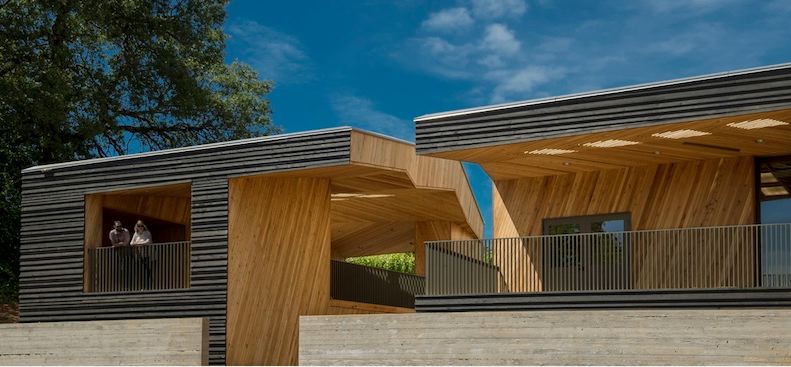 The Wine Dudes In collaboration with Eric Anderson of Grape Nutz and Grape Radio, I am writing a weekly wine blog for Orange Coast Magazine which covers a range of wine related subjects and a weekly Must-Try Wine. Here is my latest entry. Check us out at www.orangecoast.com.
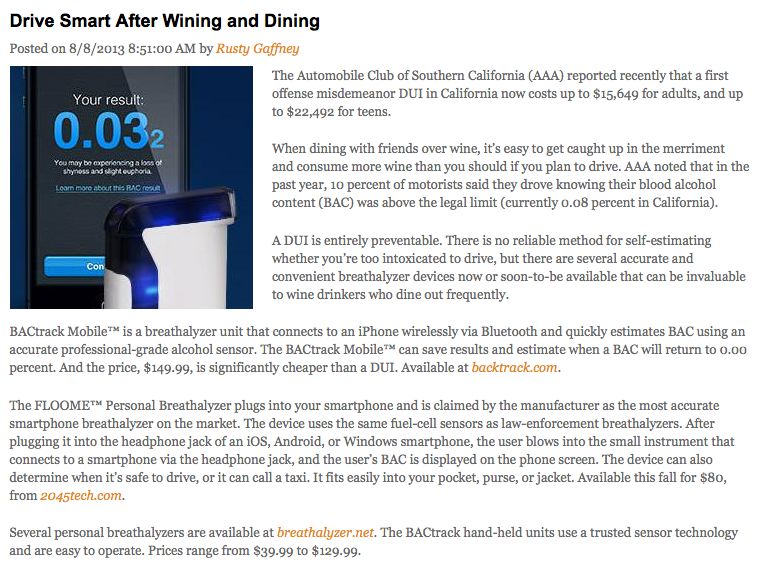 Family Winemaker’s The annual Family Winemaker’s tasting in San Francisco will be held on Saturday, August 17, at Fort Mason. Hundreds of family wineries share their wines with folks from the trade and consumers alike. For tickets, visit www.sfconsumer13.eventbrite.com. Video on Varietals I liked this humorous short video on varietals from Paso Robles: www.youtube.com/ watch?v=DfTaMzV4oFo&feature=youtu.be. Open Wine Bottle Without Popping the Cork Coravin’s Wine Access System 1000 is a device that replaces the traditional corkscrew worm with a thin, hollow needle. When you push the needle into the cork, it releases a small amount of argon into the bottle which pressurizes the contents and forces wine up into the needle and out of the spout, preventing air to get in. The Coravin opener costs $300 so its primary market is restaurants that don’t want to open expensive bottles when the demand is uncertain. See the video www.gizmodo.com/magical-bottle-opener-can-pour-wine-without-popping-the-967410908. Sending Pinot Noir to the Microwave A recent report from the Tasmanian Institute of Agriculture has shed new light on the potential use of microwave technology in the winery. The “controlled phenolic release” process, or CPR, uses microwaves to extract grape skins and juice at 70ºC. The longer the exposure, the more depth of color and tannin level can be achieved. The process decreases the traditional maceration process. Trials with Pinot Noir have shown that microwaved wines which are pressed off their skins before fermentation had about the same color and tannin levels as wines fermented on skins. Significantly, Pinot Noir wines that were microwaved and then fermented without skin contact resulted in wines that had high levels of aroma compounds that are responsible for cherry and chocolate aromas in wine. If the microwave exposure (maceration) occurs before fermentation, there could be less chance of producing harsh tannins. The treatment also sanitizes the must, removing background yeast and bacteria. Harmonique Opens New Tasting Room Harmonique, based in Anderson Valley and owned by Bruce and Moira Conzelman, has opened a new Tasting Room in Boonville in the former Londer Vineyards location in the John Hanes Art Gallery at 14051 Highway 128. The Tasting Room will be open Thursday through Monday from 11:00 to 5:00. Visit www.harmonique.com for more information. Amorim’s Latest Weapon for TCA Amorim, the world’s largest cork manufacturer, has developed a prototype that will allow the testing of individual corks for TCA compounds responsible for corked wine (The Drinks Business, July 25, 2013). A current gas chromatography system in use at Amorim requires 14 minutes to test each cork sample, but the new prototype can analyze one cork every 20 seconds allowing Amorim to screen up to 1.5 million of the 3.6 billion corks produced yearly. The technology would initially be used on the company’s highest quality corks. Since 2003, the Cork Quality Council has reported that its members reduced TCA by an average of 84%. Study Reveals Commercial Yeast Controls Fermentation Andy Perdue reported (Wine Business Monthly, August 2013) the results of three years of research at the University of British Columbia in Canada. The study was conducted by graduate student Jessica N. Lange working with biology professor Dan Durall. They studied yeast during several stages of fermentation of Pinot Noir and found that regardless of which yeast started the fermentation (indigenous or otherwise), a commercial strain eventually dominated the process and eliminated other forms of yeast that were present. Ken Wright, owner of Ken Wright Cellars, was fascinated by the findings and has started research in Oregon with several other wineries to replicate the graduate student’s findings. If confirmed, the idea of indigenous fermentations would be a non sequitur. UC Davis Brett Aroma Wheel Dr. Ann Noble, a professor at University of California at Davis, and a number of colleagues, have created the Brettanomyces Aroma Impact Wheel (Wine Business Monthly, August 2013). After studying Brettanomyces yeast strains and their byproducts in wine along with the results of sensory evaluations by human panels, a wheel was introduced. I found it very interesting that there was such a wide range of Brett spoilage compounds. Barnyard and horsey are often mentioned but spoilage compounds can produce aromas of vinegar, nail polish remover, cheese, dairy, sweat, and rotting meat. The researchers pointed out that Brett detection levels can be highly variable among different individuals and the wine in which it exists.
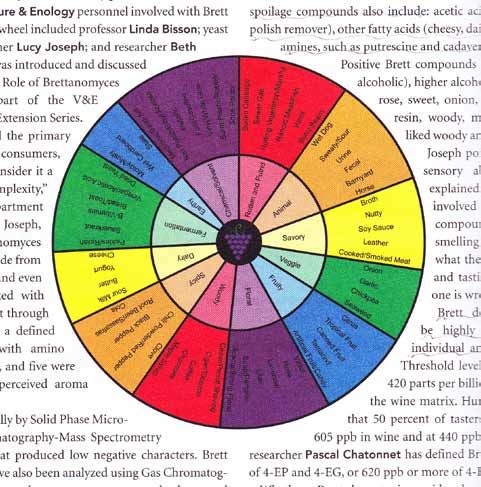 Big Events for Carlton Carlton’s Walk in the Park will be held Saturday, August 17 and Sunday, August 18 at Wennerberg Park. Only $15 to enjoy both days of wine, food, art, music, nursery plants, and a classic car show. Visit www.CarltonsWalkinthePark.com. Carlton Crush Harvest Festival will be on Saturday, September 14, in downtown Carlton. Grape stomp competition, wine thief relay, barrel rolling race, wine, beer and cider garden, local artists, food, and live music and entertainment. No admission fee. Visit www.carltoncrush.com. Lenné Investment Opportunity A custom crush facility, Artisan Wine Works, will be established at Lenné Estate. Lenné’s proprietor, Steve Lutz, is offering minimum 50K investments for each unit in the facility. Each unit receives an amortized loan at 4% paid annually, five cases of wine annually which can be privately labeled, invitation to participate in two educational and food events per year, and a 25% discount on Lenné wines. Contact Steve at 503-956-2256 or steve@lenneestate.com. The West End Tasting Rooms in Dundee Located at 1326 Highway 99W in Dundee in the building housing the Inn at Red Hills and Paulée Restaurant. The West End will offer tasting of wines by Le Cadeau Vineyard, Tertulia Cellars (Walla Walla) and Evening Land Vineyards. Lompoc Wine Ghetto Relaunches Website The Lompoc Wine Ghetto in the Santa Rita Hills is growing and in an attempt to attract more visitors west of Buellton, the vintners in the Ghetto and nearby Lompoc have relaunched their website as www.lompoctrail.com. The site is very professional and easy to navigate. A printable map of Lompoc tasting rooms is available on the site. Lompoc (“Lom-poke”) has the second largest concentration of tasting rooms in Santa Barbara County. Now 19 tasting rooms call the industrial park known as the Lompoc Wine Ghetto home. Noted Pinot Noir producers located in the Ghetto include Ampelos Cellars, Arcadian Winery, Fiddlehead Cellars, Flying Goat, Longoria Wines, Samsara, Tyler Winery and Zotovich Cellars.
 Babcock Develops New Pinot Noir Clone According to the Santa Barbara Independent (August 8, 2013), Bryan Babcock, the veteran winemaker at Babcock Winery, has devoted the last 20 years to developing his own Pinot Noir clone or selection from a suitcase cutting that was supposedly brought into California from a DRC vineyard in Burgundy. It is named the Psi (PSI) clone, which Babcock plans to trademark and release to the viticulture market one day. Currently, Babcock offers a PSI Clone Pinot Noir. Read the PSI clone story at www.babcockwinery.com/psi-clone. Great Wine News Check out this new, free online wine magazine and weekly newsletter. Articles are of general interest and not too technical with a light, relaxed approach to wine reporting. Beautiful photography and graphics. No reviews, just easy reading. Visit www.greatwinenews.com.
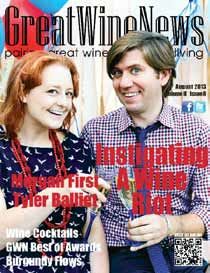
Rating Pinot Noir is a Daunting Task
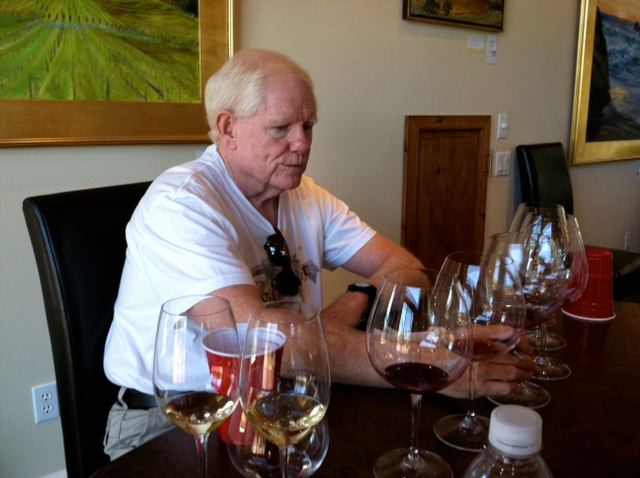 I thought that when I started rating Pinot Noir using the 100-point scale it would be a no brainer since I had been drinking Pinot Noir for years and thought I knew the great from the very good from the ordinary. I have since assumed a conciliatory stance for the following reasons. Bottle Variation This is a well-known phenomenon experienced by vintners and wine critics. In any case of wine there always seems to be a few outliers that don’t match up to the pedigree of the rest of the flock. “Cameleonity” of Pinot Noir Pinot Noir can change in the bottle in a heartbeat, and what tasted great last week may taste like lees-infested grape water the next. So when you taste a Pinot Noir makes a huge difference. Regional Differences Russian River Valley struts out its gobs of plush fruit, while the Santa Cruz Mountains looks to more secondary, tertiary flavors including minerality and subtle nuances. Oak Oak is catnip for humans so many drinkers love oak-drenched Pinot Noir. Me? I abhor it, but should I denounce a wine that is oak-themed just because personally I am not a fan? I believe Pinot Noir loves to date oak, but doesn’t want a serious commitment. No one knows exactly what Pinot Noir is supposed to taste like, but I don’t think oak is high on the list. Predicting the Future Can anyone honestly tell what a wine will taste like in 1, 2, 5 or 10 years? Experience has taught me to understand the potential of wines that don’t excite on release but this is not exact science. Predicting the evolution of a wine is better off in the realm of fortune tellers. Fruit is the Big Teaser Pinot Noir wines with flashy, busty fruit are hard to ignore. These wines frequently impress at tastings. Often referred to as “Parkeresque,” these wines please many consumers while causing consternation among wine reviewers like myself. Palate Differences I have often met wine drinkers who absolutely love a Pinot Noir that I abhor for various reasons. I am convinced that your palate is your patrimony and is not particularly receptive to others’ dictates. In other words, I can illuminate and direct your Pinot Noir experience, but I cannot be your Pinot Noir experience. Plenty of Good Shit Nowadays there is very little bad Pinot Noir. Rating American Pinot Noir is a frustrating exercise in splitting hairs because there are many more Pinot Noirs in the marketplace that are deserving of high scores. Be thankful and go with it. |